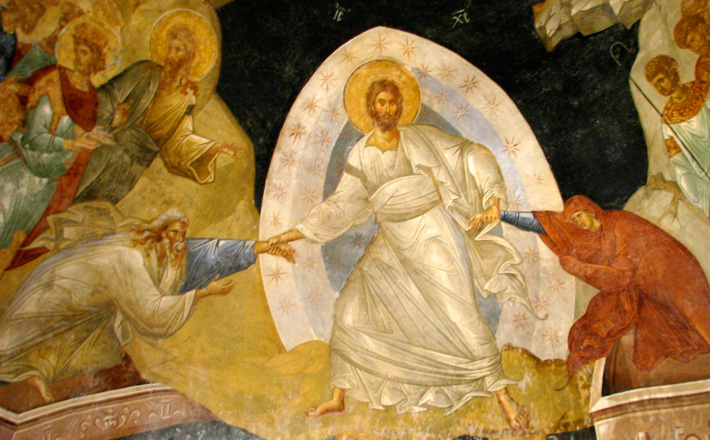Commentary on Luke 20:27-38
This passage, quite frankly, most likely will sound odd, archaic, and even irrelevant to most of our hearers.1
But opening up its narrative, historical, and contemporary implications may assist those who want to preach it, even — and perhaps especially — on All Saints’ Sunday, on which it happens to fall this year.
Narrative Elements
While giving significant time in recent weeks to Jesus’ journey to Jerusalem, the lectionary has skipped several important passages that frame the narrative setting of this passage. Namely, Jesus’ journey has drawn near its conclusion. As Jesus approached Jerusalem, multitudes of “disciples” (“many people” in Mark, “crowds” in Matthew) greeted him with the royal acclamation, “Blessed is the king who comes in the name of the Lord.” As he drew within sight of the city, Jesus weeps for sorrow over Jerusalem’s lack of recognition of him and for its imminent future. Upon entering the city, Jesus goes to the Temple, not to worship or pay homage but to drive those selling sacrifices from its premises. Jesus then takes up residence there, teaching in the Temple, as Luke says, everyday, while his opponents seek the opportunity and means by which to kill him.
This compact series of events constitute a palpable intensification of the tension and opposition that has characterized the relationships between Jesus and the religious authorities of the day. Nor does this tension abate in the scenes immediately preceding today’s passage, as Jesus’ authority is first questioned (20:1-8), he then tells a provocative — some might say incendiary — parable (of the wicked tenants) (20:9-19), he evades a rhetorical trap about paying taxes (20:20-26), and now is invited into a similar snare with a question about the resurrection. Jesus again avoids the traps of his interlocutors, answering so well that his opponents are silenced by the astuteness of his answer. Placing this scene in its proper narrative context as part of the drama and contest that leads to the crucifixion is essential to reading and preaching it well.
Historical Elements
The primary historical element that will demand some attention is the role of the Sadducees, who though in some ways the rivals to the Pharisees, were united with them in their opposition to Jesus. The Sadducees had primary authority over the Temple. They recognized only the original five “books of Moses” as fully authoritative, and for this reason did not believe in the resurrection of the dead (as that is not referenced in the Pentateuch). Because Jesus had so recently attacked the sacrificial practices of the Temple, it is easy to understand that they would put away their differences with the Pharisees in order to discredit Jesus (though by cornering him on the question of the resurrection they may also seek to embarrass the Pharisees who similarly believe in the resurrection). The law they referenced — called levirate marriage from the Latin levir (“brother in law”) comes from Deuteronomy 25:5-10 and sought to insure the preservation of one’s family name by stipulating that a man should marry the childless widow of his brother. The question is hypothetical, meant to take an ancient practice to the extreme in order to show that the whole idea of resurrection was foolish.
Jesus avoids their trap by making two moves. First, he demonstrates their failure to understand the resurrection — resurrection life, contrary to the assumption betrayed by their question, is qualitatively different from life here and now. Second, he demonstrates their failure to understand Scriptures by using another passage from the Pentateuch — the crucial Exodus 3 story of Moses’ encounter with God in the burning bush and the revelation of God’s holy name — that he takes to establish the validity, indeed certainty, of life after death. (The passage, Jesus points out, declares that God is — present tense — the God of Abraham, Isaac, and Jacob, not that God was their God. Therefore, Jesus concludes, Abraham, Isaac, and Jacob must in some sense still be alive; hence, the necessity of resurrection.)
Because the Sadducees fall largely off the scene as figures to be contended with after the destruction of the Temple in 70 CE (notice that the Evangelists need to explain to their hearers that Sadducees don’t believe in the resurrection), it is perhaps curious that Luke, following Mark, would include this story. Perhaps there were questions in his community about resurrection; certainly other communities wrestled with similar concerns (see I Corinthians 15). Or perhaps it was a legacy of the controversy between Jesus and the religious authorities, as Luke references the disagreement between Sadducees and Pharisees again in Acts (23:6-10).
Contemporary Elements
Whatever the historical concerns that caused Luke to retain this story, and paying attention to the narrative role it plays, this passage may certainly address some of the questions and concerns contemporary Christians have about resurrection. Two questions in particular might well occupy the preacher.
First, what is resurrection like? Further, and perhaps more to the point, how much will our resurrection life be like our life in this world? And what will our relationships be? This passage gives few specific answers to such questions, though it does stress that we should not limit our imagination — let alone God’s design — for life after death by our own experiences. Eternal life will be qualitatively different from what we know in our temporal existence. Time itself — and with time death — will have ceased. Because we are such creatures of time — ceaselessly aware of the fleeing present bound by past and future — this is hard for us to comprehend. For this reason, I’ve found it helpful to resist describing resurrection and heaven in temporal terms, sometimes favoring spatial and relational references which, while also limited, at least draw attention to the qualitative, rather than quantitative, differences. We might say, for instance, that in resurrection we will live in the “nearer presence” of God. Further, while we do not know what relationships will be like, we know that we will be related to each other in and through our relationship with God.
Second, how does resurrection compare with immortality? Though a Greek notion, many Christians today and, indeed, throughout the centuries, have confused immortality with resurrection. But whereas immortality of the soul promises that some spiritual element of a person persists beyond the physical death of the body, resurrection insists that the whole person will in some way be united with God (see I Corinthians 15, especially 35-49). It is the whole person, not some wispy essence, that God promises to redeem. We do, in fact, die — there is no escaping that. But because of the One who died on the cross and was raised again from death, we live and die with the promise that God will similarly raise us from death to new life where, in the words of Jesus today we “cannot die, because [we] are like angels and are children of God, being children of resurrection” (20:36).
This is, of course, only one passage, and so it should not be taken to be either the first or last word on resurrection. Yet given how much talk is going on in other circles about life after death, this might be a good occasion to insert a Christian voice into the ongoing dialogue.
Notes
1. This commentary first published on this site on Nov. 7, 2010.


November 6, 2016